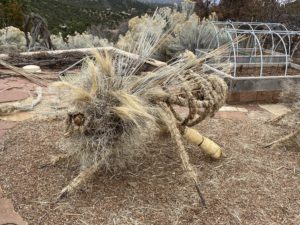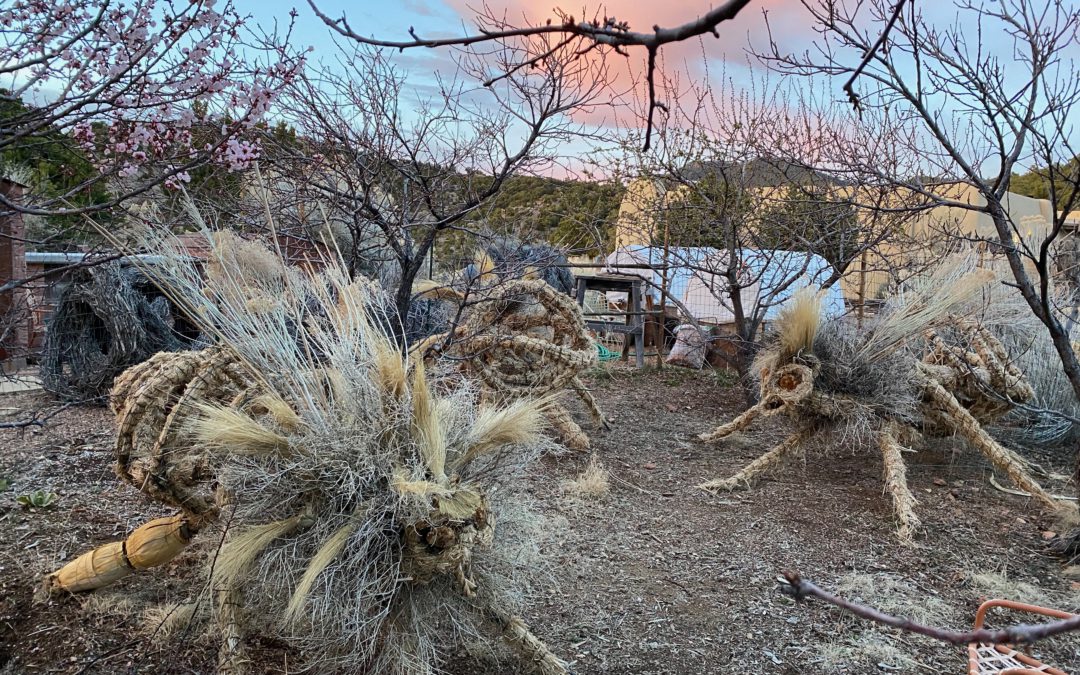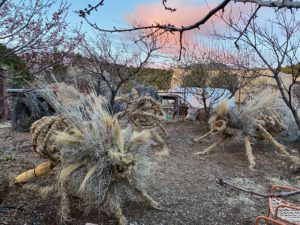 Last summer I made a commitment to the Botanical Garden to teach indigenous plant sculpture in late October in Santa Fe. Thinking it would be exciting to bring these materials and processes to other creative individuals and see what they come up with, I went about inviting the public to take part.
Last summer I made a commitment to the Botanical Garden to teach indigenous plant sculpture in late October in Santa Fe. Thinking it would be exciting to bring these materials and processes to other creative individuals and see what they come up with, I went about inviting the public to take part.
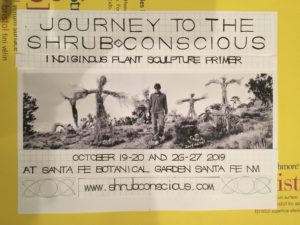
I designed the shrubconscious website and the flier announcing “Journey to the Shrubconscious,” and posted it at universities, art schools and garden centers, as well as coffee shops and random bulletin boards up and down the Rocky Mountains from Ft. Collins to Albuquerque. Because I was already going there, I canvased Berkeley, Oakland, San Francisco and Marin County, California as well.
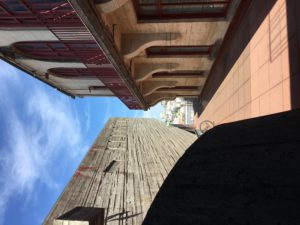
Human beings are more than just heads with eyes for looking at screens. I myself had been writing five or more hours a day in front of one for decades. When I first entered the shrubconscious, I found ample fertile ground in nature for inspiration and imagined other creative types also desiring to step away from machines for some fresh air.
But, surprisingly, no one stepped up for the workshop. Not one single soul expressed curiosity. So, the Botanical Garden and I agreed to reschedule and those late October calendar days were unexpectedly sprung wide open.
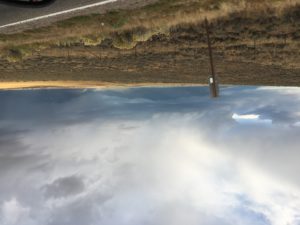
Almost instantly an opportune event appeared on my news feed. An intriguingly titled , “High Desert Hempfest” would take place in Taos the very same day.

I had been thinking of sculpting hemp and had been making contacts with folks in the industry for months. High Desert Hempfest would be a perfect time and place to make my first attempt.
Hemp must be the most versatile crop humankind has ever known. No other plant can provide as many cures for the 21st Century’s ills, including medicines, clothing, foods, construction and fabrication materials, fuel and don’t forget art. Plus, it restores the very soil in which it is grown.
The Colorado Hemp Industries Association returned my call and put me in touch with a farmer that had what I needed. So I left a message with the High Desert Hempfest and pitched my idea on their machine. Then I packed my cooler, truck and tools.
Everything fell together. I drove north a few hours, met the grower in his field, which had recently been harvested for the flowers, leaving windrows of crimped hurd, (hemp fiber) lying on the ground. We had a brief chat. Like most farmers, he was busy. He cultivated over 3,000 acres last year. This was his sixth season and they were all in for next one as well. I told him my plan. He gave me his blessing and left.
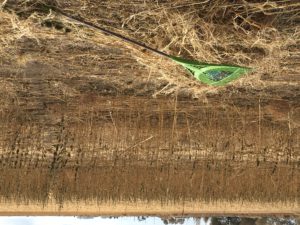
With a garden rake, a short amount of time and a bit of sweat, my pick-up bed was loaded. I turned back south headed for Taos.
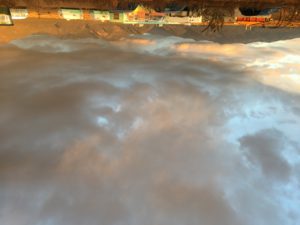
As if it were all meant to be, the festival organizer had retrieved my proposition from their machine, by the time I arrived and provided a prominent location where, next day, I would commence with my scheme.
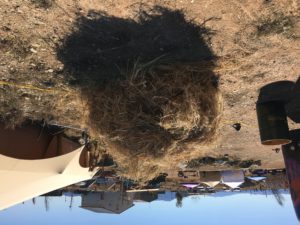
A design for the first hemp sculpture had already come to me. There were sketches in my journal with assorted notes and dimensions.
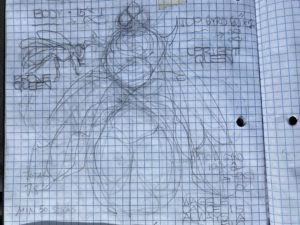
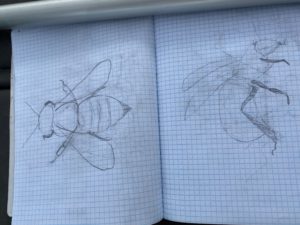
For this one, I chose a honeybee because hemp helps bees. It grows fine without pesticides and its healthy pollen feeds the bees.
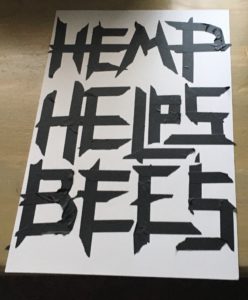
Hemp and bees, bees and hemp, heaven and earth come together symbiotically in these two elegant agents of sane and sustainable ecology.
There is probably no better teacher in all of nature than bees. Observing them in a hive is surely more instructive than watching things on screens. Beekeeping should be taught to all first world teens.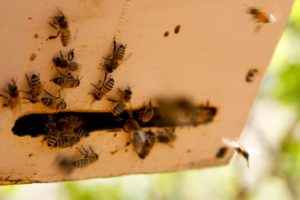
Like teens, bees dance in groups. Their in hive boogie resemble figure eights. Each one reveals precisely how far, and in what direction to venture forth for food.
Coincidentally, I have always been attracted to figure eights and employ them often in design. So a figure eight became the foundational form for this latest creation of mine.
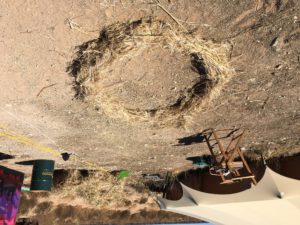
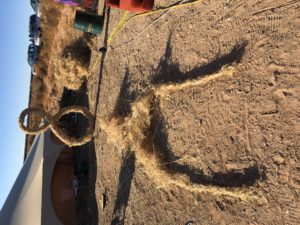
It turned out to be a gorgeous day in Taos. The sky was turquoise. The sun was warm and the wind, mild.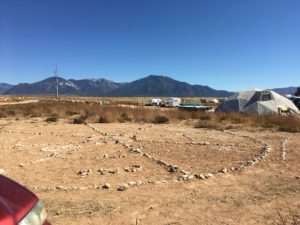
In the eight hours I labored, a rudimentary form emerged and stood up on its own just before dusk. The festival attendants that I engaged with seemed suitably impressed.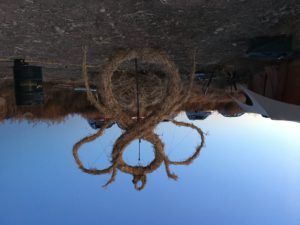
I knew there was a lot more I could do to invest that queen bee with majesty, but it would take time.
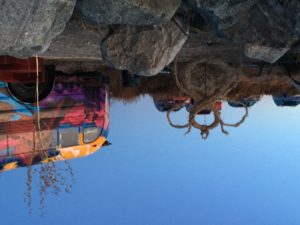
High Desert Hempfest was a laid back event, but I think anyone would judge it a success. That said, I was preoccupied with my task and had no leisure to take in much else. There were craft and food booths, other demonstrations. I labored right next to the music tent with a program of players and keynote speakers that were exceptionally fine to hear, while I worked on my design. After a bite to eat, a bit of rest, and watching a talented duet perform a set, I said goodbye to the festival folk and brought my creation home to where I could make it look its best.
This past winter there were many mild days. In between cold spells, I got myself out to the yard and worked hard. Some days were work, others were play.
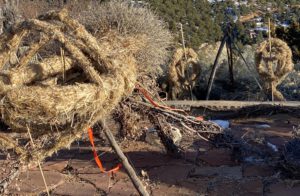
I found sculpting with hemp so agreeable in fact, it wasn’t a much of a stretch to make two more bees.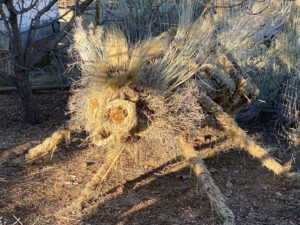
The original had been a queen, as I have said, but how would anyone know unless there were a drone and a worker all in line?
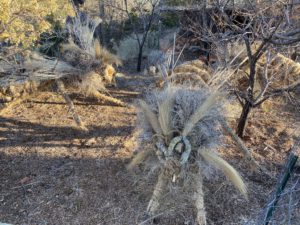
And how much more impressive would it be when you came upon, not one, but three gigantic bees for the first time? Here they are in our garden keeping out the deer.
